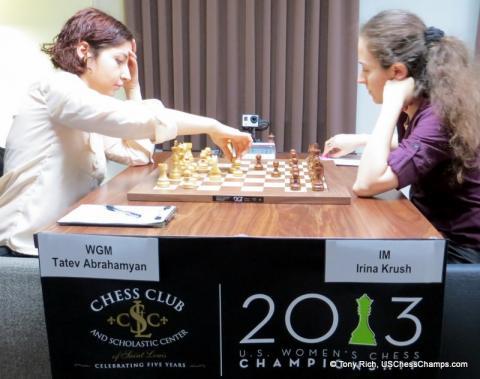
Personal Experience at the US Women's Championship
My next few articles will be about the US Championship that took place from May 2-13th in St. Louis. I was a participant in the women's event, where ten players competed for a purse of $65,000 and the title of US Woman Champion. This event is grandiose, thanks to the generosity of benefactors Rex and Jeanne Sinquefield. Classy opening and closing ceremonies with local officials and media attending, playing at the St. Louis Chess Club and Scholastic center, which is gorgeous and located on one of the main streets in the exquisite West End area - one could not ask for more! Moreover, the players were hosted in luxurious Chase Plaza Hotel, which is five minutes walk from the club. The Championship is a treat - the event of the year for many participants who actively plan tournaments and monitor rankings to make sure to qualify.
The women's event featured a round robin format (2nd year in a row) with ten participants, including the US Woman Champion, the seven highest-rated players, and two wildcards. The top two ranked female players in the nation have consistently maintained the status quo by winning this event over the span of past eight years. They are Anna Zatonskih and Irina Krush - and not surprisingly that the title this year went to Irina Krush, who scored an impressive 8/9. Anna took a second place only half point behind, where the 3rd place went to Tatev Abrahamyan who was very close to challenging the status quo this year. She plays chess professionally these days, represents US on the national team for few years and clearly deserves to be among top three. I tied with Camila Baginskaite for the 4-5th places, which is quite respectable. Wild cards went to youth this year - Alena Katz and Sarah Chiang, who are top ranked female juniors in the nation. Alena had a significant improvement in her play from the previous year, while Sarah had a rough start but managed to finish the tournament strong. I think it is a very good idea to give wild-cards for a prospective youth and grant them experience of playing top female players in the nation!
Today I would like to share some of the ideas and critical positions from the first three rounds...
The first round is always the toughest. If your form is bad then you can probably try playing something safe and hope to get out of a bad streak. However, if form is good then maybe play for more complex positions. Having white, I played Karpov's variation in the Nimzo and did not quite grasp the move order that Sarah chose.
I was not familiar with this move order where black plays h6 without Nd7 first. If the knight is already on d7 then after h6 I can take the knight on d7 and then capture the knight on f6.
What can I say? I was familiar with this combination but didn't see it happening at the board. Here I realized that my position is worse and figured to play something solid to keep it together.
I thought this position was roughly equal, and therefore held good chances for a draw. Black has a choice of where to retreat the bishop. The best way is to exchange it for the knight. The knight is quite strong as it defends the weak g2-square, whereas the Bg3 can be threatened with h5-h4. Black traded the wrong way and ended up with ineffective battery of queen and rook on the g-file. After that, white has comfortable pressure due to active pieces, and after some maneuvering I managed to win.
In the second round I already had a tough pairing against Irina Krush. She prepared solid Petrosian line against my King's Indian Defense, which is a good choice against lower-rated player like myself, as the line aims at long positional struggle and whoever plays better wins. Let us skip the opening as although I didn't know the theory after Be3 move by making logical moves we followed one of Kramnik's games up to this position:
In Gelfand's game he took on f4 a move earlier and eventually drew (the game is shown in annotations). Playing e4 is not bad either. White will get a strong square e3 for the knight, which will attack the f5-pawn from there. The h5-pawn is a weakness too, but black has the open g-file, putting pressure on the g-pawn.
Before the time-control we got into complications, but all this time the position stayed around equality. However, my 40th move was a mistake and few next moves too, leading to a rather shocking ending where white checkmates. The reason Rb8 is a bad move here is that black has no time for grabbing the pawn after R:b4. Attacking the bishop right away will deflect white rook from the kingside's attacking position and black will have time for f:g4 capture.
Despite the loss I was happy about the overall quality of the game and was looking forward to the next round game against Ni. She recently started playing Nimzo as black but I did not have enough of her games in the database to prepare a specific line against her. She chose a particular set-up in Hubner variation with Kh8, which was recently implemented by Grischuk and repeated a month later by Tkachiev. I knew about these games, and Edouard's annotations to his game with Tkachiev were still fresh in my memory.
Black should be very careful as the Bh3 can fall out from the game. White's plan is to play f4 but sometimes it is f3-g4, locking the bishop on h3, which can be captured by a Kf2-Kg3 maneuver. The idea of Kh8 is to free the g8-square for the knight without weakening moves such as h6. After the knight moves black is free to play f5. As shown in the annotations Tkachiev implemented a novelty: Qd7, which tactically prevents f4 break, white went on and adjusted the plan with f3-g4 set-up. The way Ni played f4 was a strong move but I didn't remember all the variations during the game and opted for a safe, long-term edge.
Next week I will show few more of my games from the Championship!






